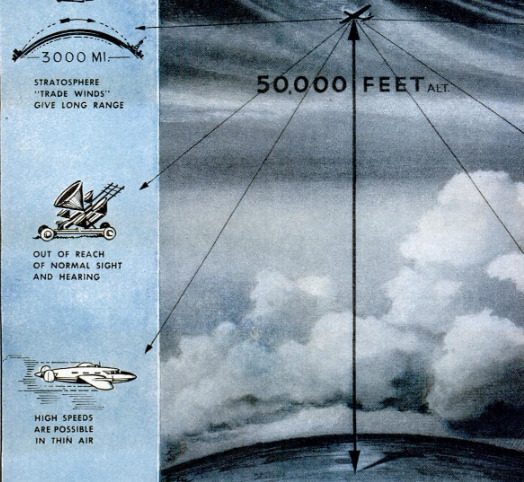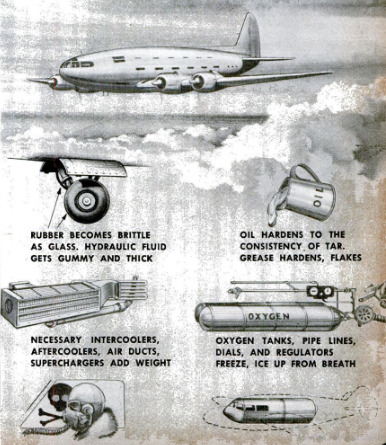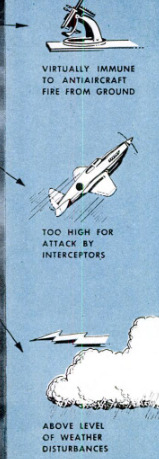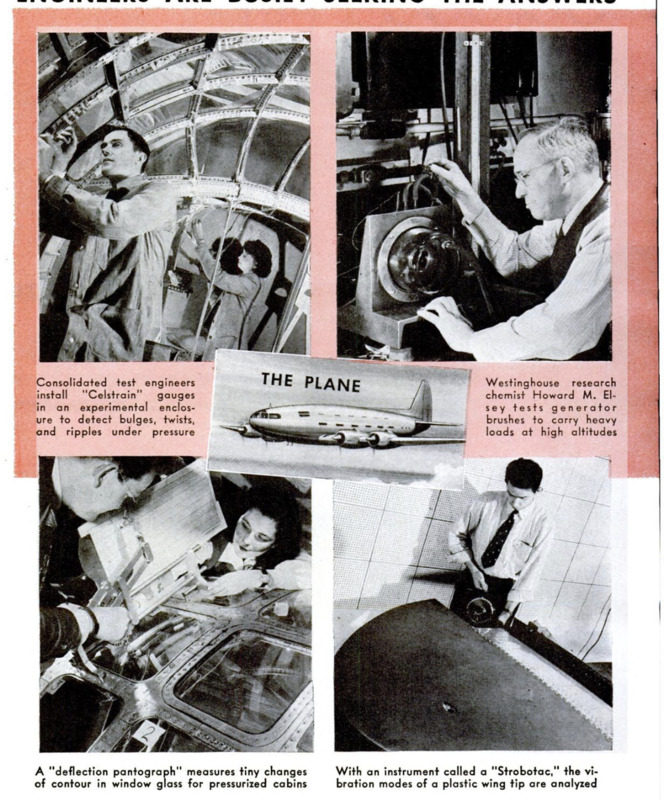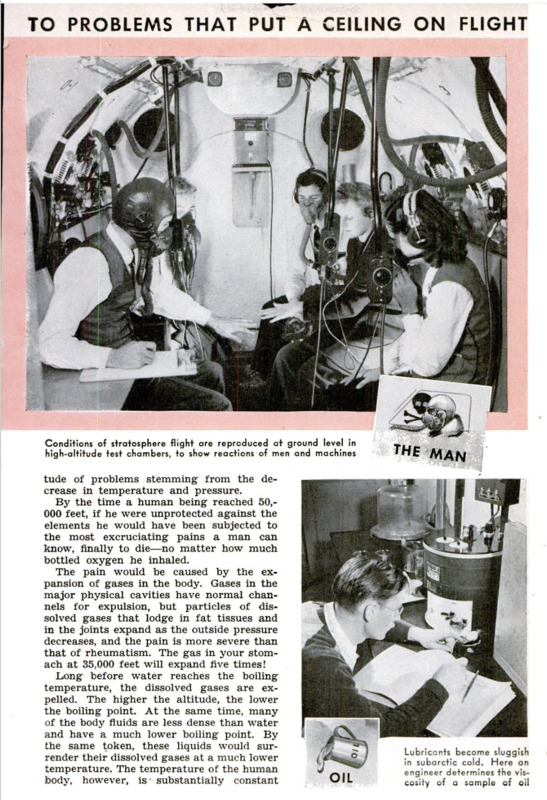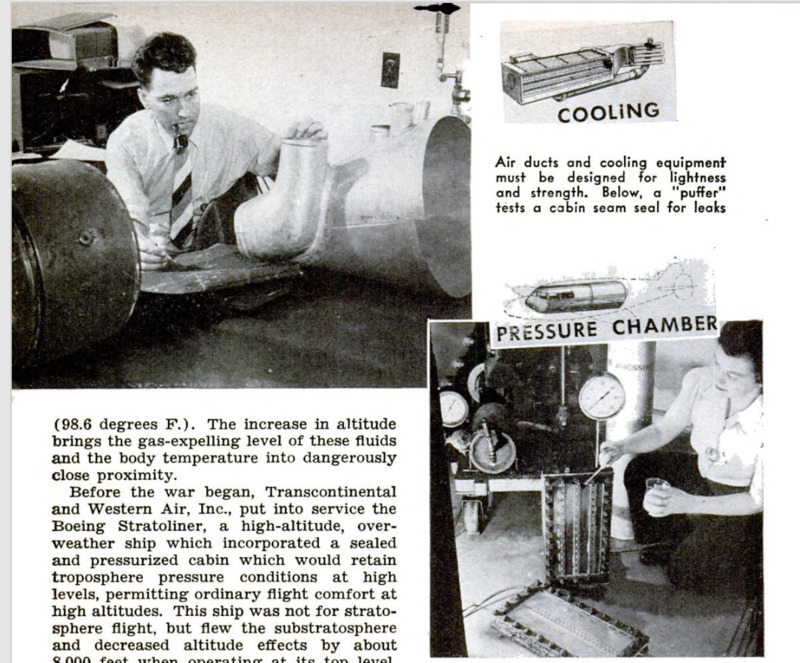-
Titolo
-
Can We Fly at 50.000 Feet?
-
Article Title and/or Image Caption
-
Can We Flight at 50.000 Feet? Dragging his planes to ever higher levels, man encounters deadly enemies in cold and low air pressure...can science conquer the stratosphere?
-
extracted text
-
MODERN military air operation has es-
M tablished certain advantages for high-
level flying. The first, of course, is virtual
immunity from antiaircraft fire. Another is
freedom from interception, because the
higher the airplane flies, the greater the
time lapse before intercepting aircraft can
climb to the level of the high-flying ship.
At 40,000 feet, the true air speed of a ship
is twice that of the same ship at sea level;
the upper winds are steady and reliable,
and, once charted, can be depended on,
month in and month out, to be there as an
aid to operation. Furthermore, because
virtually all the weather phenomena occur
in the troposphere, or lower level of the air,
conditions in the upper levels are constant
and reliable.
For the same reasons, many long-visioned
planners of postwar air lines are looking
forward to the development of high-altitude
equipment for long-range travel in the days
ahead.
The 50,000-foot level, from an operational
viewpoint, looks like an attractive place to
fly. The weather is, for all practical pur-
poses, constant, varying only a little with
latitude. Above the level beginning at
around 36,000 feet, the air is perfectly dry;
the temperature is almost constant at -55
degrees C. (67 F.). The barometer, which
normally stands at 760 mm. of mercury on
the ground at sea level, reads 87.30 mm. at
50,000 feet—or .1518 the weight of normal
air.
Man and his flying machine are intruders
at that altitude, and nature treats them as
such. The machine must carry heavy and
cumbersome equipment to supply its engine
with enough air to burn fuel needed |
to stay on the wing. Man himself is |
like the proverbial “fish out of water,”
and must surround himself with as
close to a synthesis of ground condi-
tions as possible in order merely to
stay alive.
When man was satisfied to call 20, |
000 feet high altitude, his problems
were comparatively simple. Warm clothing
solved the problems of adequate body heat;
bottled oxygen solved his air problems. The
major questions were mechanical—getting
the engine to produce enough power to keep
the airplane in flight in the thinned-out air.
Both man and motor suffer from reduced
air pressure. The motor is given more oxy-
gen by feeding it forced air (supercharg-
ing); man is supercharged by his oxygen
equipment. As the ship sought more alti-
tude and the application of superior super-
charging made higher ceilings possible, both
man and the airplane were beset by a multi-
tude of problems stemming from the de-
crease in temperature and pressure.
By the time a human being reached 50,-
000 feet, if he were unprotected against the
elements he would have been subjected to
the most excruciating pains a man can
know, finally to die—no matter how much
bottled oxygen he inhaled.
The pain would be caused by the ex-
pansion of gases in the body. Gases in the
major physical cavities have normal chan-
nels for expulsion, but particles of dis-
solved gases that lodge in fat tissues and
in the joints expand as the outside pressure
decreases, and the pain is more severe than
that of rheumatism. The gas in your stom-
ach at 35,000 feet will expand five times!
Long before water reaches the boiling
temperature, the dissolved gases are ex-
pelled. The higher the altitude, the lower
the boiling point. At the same time, many
of the body fluids are less dense than water
and have a much lower boiling point. By
the same token, these liquids would sur-
render their dissolved gases at a much lower
temperature. The temperature of the human
body, however, is' substantially constant
(98.6 degrees F.). The increase in altitude
brings the gas-expelling level of these fluids
and the body temperature into dangerously
close proximity.
Before the war began, Transcontinental
and Western Air, Inc., put into service the
Boeing Stratoliner, a_ high-altitude, over-
weather ship which incorporated a sealed
and pressurized cabin which would retain
troposphere pressure conditions at high
levels, permitting ordinary flight comfort at
high altitudes. This ship was not for strato-
sphere flight, but flew the substratosphere
and decreased altitude effects by about
8,000 feet when operating at its top level.
The first problem to be solved in the busi-
ness of high flight was that of engine super-
charging. Naturally, when one left the
greater part of the atmosphere below, the
engine would feel the effects of oxygen
starvation long before the pilot. Super-
chargers are simply rotary compression
pumps that provide sea-level air to the en-
gine at higher altitudes. Dr. Sanford Moss
gave mankind the key to stratosphere fly-
ing when he designed the exhaust-driven
turbo-supercharger toward the end of the
last war. However, it opened the way for
a multitude of subsidiary problems. For in-
stance, the heat resulting from extra com-
pression necessary at extreme altitudes is
0 great that special cooling apparatus must
be used to reduce temperature. These “in-
tercoolers” and “aftercoolers” used with
high-altitude supercharger equipment add
to weight, bulk, and complication.
The coefficient of expansion of aluminum
1s about twice that of steel. At ordinary
temperatures, this difference would be too
small to warrant serious consideration.
However, when the temperature drops to
67 degrees F., the tiny difference mounts.
Multiplied by the 67-foot length of the typi-
cal four-engine transports fuselage, the
difference is manifested in the slacking of
control cables. Particularly at high alti
tudes, this lost motion can be dangerous.
The first step in solving this problem
was the installation of a tension gauge on
control lines, so that adjustments could be
made manually. Currently, research is be-
ing conducted to determine what method—
wprings, hydraulic cylinders, _ete.—would
adequately take up this free play without
giving the pilot another detail to worry
about in the stratosphere.
The stratosphere itself should be its own
best research laboratory. In theory, the
best way to find out whether something
will work at 40,000 or 50,000 feet is to take
it up there and find out. That is the way
the earliest pioneers tried it, and the ex-
perimental trail is littered with their bones.
A recent example of this realistic testing
was the parachute jump from 40,200 feet
made by Lieut. Col. William Randolph Love-
lace near Euphrata, Wash, on June 24. The
35-year-old chief of the Aero-Medical Lab~
oratory at Wright Field, Dayton, Ohio,
wanted to make a personal test of bail-out
oxygen equipment for high altitudes de-
veloped under his supervision. Although he
tad never jumped
before, he made the leap—one of the highest
on record—with no mishap beyond a frozen
hand.
Now, scattered over the nation, in the
plants of major aircraft companies, in col-
leges, or at military and Government re-
search plants, are special wind tunnels, cold
chambers, and low-pressure chambers Which
can synthesize high-level conditions so that
we can explore the mysteries in comfort
and safety.
One of the newest of these is the 600-
mph. wind tunnel now being built at the
Army Air Forces’ major experimental sta-
tion at Wright Field. It is to be 600 feet
long, shaped like an “0.” A 40,000-hp. elec-
tric-motor system will drive fans capable of
whipping up a 600-m.p.h. controlled gale.
The rapidly moving air will be sped through
cooling coils in which are circulated tons of
calcium chloride solution chilled to —40 de-
grees F.
To make stratosphere tests, models are
placed in a steel compartment in the throat
of the tunnel. An airtight door is sealed and
the alr is pumped out to simulate strato-
sphere conditions.
A pressure cabin in a stratosphere plane
is like a deep-sea bathysphere, working in
reverse. Its job is to keep the life-giving
pressure inside. Unlike the bathysphere, it
must be pierced in several places to allow
control cables to pass through from the
pilot's rudder and control column to the
ailerons, rudder, and elevator. The problem
has tentatively been solved by a system of
glands. In some cases, the cable may have
to pass in and out of the cabin several times.
Each of these offers a new opportunity for
the precious sealed air to escape. This prob-
lem is currently being investigated by Con-
solidated-Vultee in their high-altitude re-
search department.
There still are a number of things we do
not know about how metals will act under
conditions of extreme cold. In metal mono-
coque structure, now widely used in aircraft,
an important consideration is the yield
point, or degree of stretching and bending
that a particular metal will take and still
return to its original size and shape. Effi-
cient design calls for the use of materials
whose yield point is close to their ultimate
strength.
Windows and transparencies ae neces-
sary in high-altitude bombers, and they will
be required in the transports of the future.
‘How will transparent plastics act in the ex-
treme cold, with pressure on the inside and
virtually none without? Rohm and Haas,
pioneers in plastic resins, have recently
opened a plastics research laboratory at
Bristol, Pa., to solve some of these prob-
lems. Part of the equipment is a supercold
room where temperatures can be dropped
below stratosphere level and engineers,
working in electrically heated suits, can test
plastics for impact and pressure under all
temperatures.
Of course, the structure of stratosphere
cabins themselves is subject to considerable
test. It is essential that engineers know
what is happening to the surface of the
pressurized cabin as the ship climbs, and
the difference in pressure inside and outside
the cabin is manifested in a bulging effect.
To determine this, Celstrain gauges, tiny
assemblies of strain-sensitive wires, are fas-
tened to points where the structure tends
to be weak, such as around windows. The
gauges, in giving the changes in resistance
to electrical current in proportion to the
strain exerted, tell the engineer how the
structure is behaving at various pressures.
Windows, being made of a less highly
stressed and flexible material, are an engi-
neering weak spot. To determine how glass
will act under sudden changes of tempera-
ture and pressure, specimens are mounted
on pressure boxes and examined by polar-
ized light. The underside of the glass is
aluminized.
‘The more complicated the airplane be-
comes, the more equipment there is to be
run electrically. This adds to the drain on
the airplane's battery and generator sys-
tem. Up to a certain point, the airplane's
own generating system, driven by a spur
from the main engines in the accepted auto-
motive manner, was sufficient. With the ar- |
rival of pressurized cabins, electric cowl
flaps, etc., the burst strain possible on the
reserve was so great that it was possible
to burn out the brushes in the generator in
a few minutes. Average operational life at
30,000 feet was a couple of hours.
Westinghouse Research Laboratories re-
cently offered a solution to this problem in
the form of new chemically treated brushes
composed of porous carbon impregnated
with a lubricant which films between the
brush and the swiftly rotating commutator.
Their use allows a burst overload, eliminat-
ing, in many cases, the need for auxiliary
generators,
One by one, the problems of the conquest
of the stratosphere are being solved. |
-
Autore secondario
-
William S. Friedman (writer)
-
Lingua
-
eng
-
Data di rilascio
-
1943-10
-
pagine
-
60-64, 212, 214
-
Diritti
-
Public Domain (Google digitized)
-
Archived by
-
Matteo Ridolfi
-
Alberto Bordignon (Supervisor)
